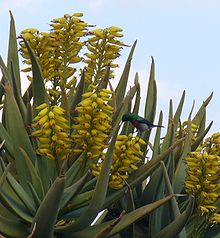Quiver tree
| Quiver tree | ||||||||||||
|---|---|---|---|---|---|---|---|---|---|---|---|---|

Quiver Tree ( Aloe dichotoma ) |
||||||||||||
| Systematics | ||||||||||||
|
||||||||||||
| Scientific name | ||||||||||||
| Aloe dichotoma | ||||||||||||
| Masson |

The quiver tree ( Aloe dichotoma ) is a species of the genus Aloes in the subfamily of the Affodill family (Asphodeloideae). The specific epithet dichotoma is derived from the Greek word "διχότομος" ( dichotomos ) for divided and refers to the two-branched branches. The common name "Kokerboom" ( Afrikaans ) was first recorded in 1685 by Simon van der Stel during his expedition through the Namaqualand .
description
Vegetative characteristics
The quiver tree grows trunk-forming with rich, dichotomous , hemispherical and dense crowns. The upright trunk reaches heights of six to nine meters and is more than a meter thick at the base. The approximately 20 lanceolate, linear, blue-green leaves sit tightly in rosettes on the branches. The leaf blade is up to 35 centimeters long and up to five centimeters wide. The very narrow, brownish yellow leaf margins are covered with 1 millimeter large brownish yellow teeth that get smaller towards the leaf tip.
Inflorescences and flowers
The three to five times branched, racemose inflorescence reaches a height of up to 30 centimeters. The broad, cylindrical, slightly tapered racemose partial inflorescences are up to 15 centimeters long and up to 9 centimeters wide. The flower stalks have a length of 5 to 10 millimeters. The bulbous flowers are 33 millimeters long, narrowed briefly at the base and widened in the middle to a diameter of 14 millimeters. The bracts are bright canary yellow. Your outer tepals are not fused together over a length of 25 millimeters. The stamens and the pen stand 12 to 15 millimeters out of flowering.
genetics
The number of chromosomes is .
Systematics and distribution
The quiver tree is widespread in Namibia and the South African province of North Cape , where it mostly grows on rocky slopes. A particularly large number of quiver trees grows in the quiver tree forest northeast of Keetmanshoop .
The first description by Francis Masson was published in 1776. Synonyms are Rhipidodendrum dichotomum (Masson) Willd. (1811), Aloe ramosa Haw. (1804), Aloe montana Schinz (1896), Aloe dichotoma var. Dichotoma , Aloe dichotoma var. Montana (Schinz) A.Berger (1908) and Aloidendron dichotomum (Masson) Klopper & Gideon F.Sm. (2013).
meaning
The quiver tree serves as a nesting place for the settler weaver .
proof
literature
- Susan Carter , John J. Lavranos , Leonard E. Newton , Colin C. Walker : Aloes. The definitive guide . Kew Publishing, Royal Botanic Gardens, Kew 2011, ISBN 978-1-84246-439-7 , pp. 690 .
- Leonard Eric Newton: Aloe dichotoma . In: Urs Eggli (Hrsg.): Succulent lexicon. Monocotyledons . Eugen Ulmer, Stuttgart 2001, ISBN 3-8001-3662-7 , pp. 131-132 .
Individual evidence
- ↑ a b c d e Doreen Court: Succulent Flora of Southern Africa . Struik Nature, Cape Town 2010, pp. 263-264, ISBN 9781770075870
- ↑ a b c Urs Eggli: Succulents . Ulmer, Stuttgart 2008, pp. 150-151, ISBN 9783800153961
- ^ Francis Masson: An Account of Three Journeys from the Cape Town into the Southern Parts of Africa; Undertaken for the Discovery of New Plants, towards the Improvement of the Royal Botanical Gardens at Kew . In: Philosophical Transactions of the Royal Society . Volume 66, 1776, p. 310 ( doi: 10.1098 / rstl.1776.0017 ).
- ↑ Olwen Megan Grace, Ronell R. Klopper, Gideon F. Smith, Neil R. Crouch, Estrela Figueiredo, Nina Ronsted, Abraham E. van Wyk: A revised generic classification for Aloe (Xanthorrhoeaceae subfam. Asphodeloideae) . In: Phytotaxa . Volume 76, number 1, 2013, pp. 7-14 ( doi: 10.11646 / phytotaxa.76.1.1 ).
Web links
- Aloe dichotoma on the Red List of South African Plants
- Aloe dichotoma: botany
- Aloidendron dichotomum . In: S. Dressler, M. Schmidt, G. Zizka (Eds.): African plants - A Photo Guide. Senckenberg, Frankfurt / Main 2014.


